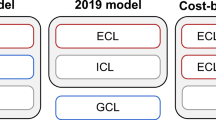Abstract
This article critiques the instructional design tools described in the special issue of Educational Technology Research and Development, Volume 50 Number 4, “Computer-Based Tools for Instructional Design.” Although focusing on four tools, (a) digital management systems, (b) CASCADE, (c) knowledge management systems, and (d) ADAPTIT, the author also comments on the introductory article (van Merriënboer and Martens), and compares the four described tools with earlier models.
Similar content being viewed by others
References
Barson, J. (1967).Instructional systems development. A demonstration and evaluation project: Final report. East Lansing, MI: Michigan State University. (Also available as ED 020673)
Bloom, B. (1968)Learning for mastery. Durham, NC: Regional Educational Laboratory for the Carolinas and Virginia. (Also available as ERIC document ED 053419)
Briggs, L., Gustafson, K., & Tillman, M. (1991)Instructional design. Englewood Cliffs, NJ: Educational Technology Publications.
Connell, J., & Shafer, L. (1989).Structured rapid prototyping: An evolutionary approach to software development. Englewood Cliffs, NJ: Yourdan Press.
Dick, W., & Carey, L. (1996).The systematic design of instruction (4th ed.). New York: Harper Collins College Publishers.
Gordon, J., & Zemke, R. (2000). The attack on ISD.Training, 37(4), 42–45.
Gustafson, K., & Branch, R. (1997).Survey of instructional development models (3rd ed.), Syracuse, NY: Eric Clearinghouse on Information and Technology.
Kemp, J. (1985).The instructional design process. New York: Harper & Row.
Nieveen, N., & Gustafson, K. (1999). Characteristics of computer-based tools for education and training development: An introduction. In J. van den Akker, R. Branch, K. Gustafson, N. Nieveen, & T. Plomp (Eds.),Design approaches and tools in education and training (pp. 155–174). Dordrecht, The Netherlands: Kluwer Academic Publishers.
Rowland, G. (1992). What do instructional designers actually do? An initial investigation of expert practice.Performance Improvement Quarterly, 5(2), 65–86.
Tessmer, M., & Wedman, J. (1993). Instructional designers' decisions and priorities: A survey of design practice.Performance Improvement Quarterly, 6(2), 43–57.
Visscher-Voerman, I. (1999).Design approaches in education and training. Doctoral dissertation. Enschede, The Netherlands: University of Twente.
Author information
Authors and Affiliations
Rights and permissions
About this article
Cite this article
Gustafson, K. Instructional design tools: A critique and projections for the future. ETR&D 50, 59–66 (2002). https://doi.org/10.1007/BF02504985
Issue Date:
DOI: https://doi.org/10.1007/BF02504985




